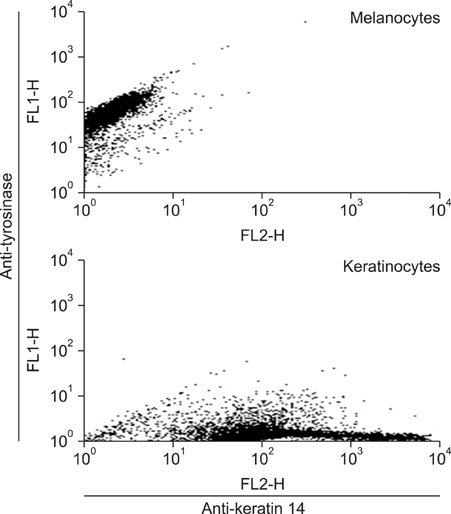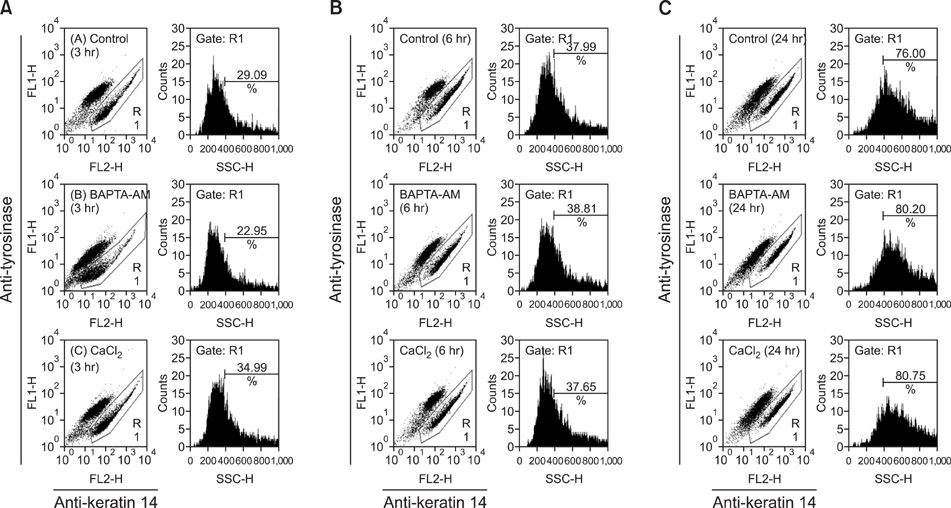Ann Dermatol.
2012 Feb;24(1):90-93. 10.5021/ad.2012.24.1.90.
A Simple Assay Method for Melanosome Transfer
- Affiliations
-
- 1Department of Dermatology, Seoul National University Bundang Hospital, Seongnam, Korea. gcpark@snu.ac.kr
- 2Department of Biochemistry, Chung-Ang University College of Medicine, Seoul, Korea.
- KMID: 2156865
- DOI: http://doi.org/10.5021/ad.2012.24.1.90
Abstract
- Pigmentation is induced by production of melanin in specialized organelles termed melanosomes and by transfer of these organelles from melanocytes to surrounding keratinocytes. The chemical basis of melanogenesis is relatively well known but the mechanism of melanosome transfer is not well studied. Various pigmentary disorders and cosmetic applications require the use of depigmenting agents. Currently available topical agents used for the reduction of pigmentation mainly include tyrosinase inhibitors and/or melanocyte-cytotoxic agents. Recently, several agents have been introduced to inhibit melanosome transfer from melanocytes to keratinocytes. However, an experimental model for melanosome transfer is not well established. In this study, a simple assay method using flow cytometry is described.
Keyword
MeSH Terms
Figure
Cited by 1 articles
-
The Effects of the 3-OH Group of Kaempferol on Interfollicular Epidermal Stem Cell Fate
Je Byeong Chae, Hye-Ryung Choi, Jung-Won Shin, Jung-Im Na, Chang-Hun Huh, Kyoung-Chan Park
Ann Dermatol. 2018;30(6):694-700. doi: 10.5021/ad.2018.30.6.694.
Reference
-
1. Wei Q, Wu X, Hammer JA 3rd. The predominant defect in dilute melanocytes is in melanosome distribution and not cell shape, supporting a role for myosin V in melanosome transport. J Muscle Res Cell Motil. 1997. 18:517–527.2. Ogawa K, Hosoya H, Yokota E, Kobayashi T, Wakamatsu Y, Ozato K, et al. Melanoma dynein: evidence that dynein is a general "motor" for microtubule-associated cell motilities. Eur J Cell Biol. 1987. 43:3–9.3. Van Den Bossche K, Naeyaert JM, Lambert J. The quest for the mechanism of melanin transfer. Traffic. 2006. 7:769–778.
Article4. Okazaki K, Uzuka M, Morikawa F, Toda K, Seiji M. Transfer mechanism of melanosomes in epidermal cell culture. J Invest Dermatol. 1976. 67:541–547.
Article5. Seiberg M, Paine C, Sharlow E, Andrade-Gordon P, Costanzo M, Eisinger M, et al. The protease-activated receptor 2 regulates pigmentation via keratinocyte-melanocyte interactions. Exp Cell Res. 2000. 254:25–32.
Article6. Minwalla L, Zhao Y, Cornelius J, Babcock GF, Wickett RR, Le Poole IC, et al. Inhibition of melanosome transfer from melanocytes to keratinocytes by lectins and neoglycoproteins in an in vitro model system. Pigment Cell Res. 2001. 14:185–194.
Article7. Lin HC, Shieh BH, Lu MH, Chen JY, Chang LT, Chao CF. A method for quantifying melanosome transfer efficacy from melanocytes to keratinocytes in vitro. Pigment Cell Melanoma Res. 2008. 21:559–564.
Article8. Romano AC, Espana EM, Yoo SH, Budak MT, Wolosin JM, Tseng SC. Different cell sizes in human limbal and central corneal basal epithelia measured by confocal microscopy and flow cytometry. Invest Ophthalmol Vis Sci. 2003. 44:5125–5129.
Article9. Rheinwald JG, Green H. Serial cultivation of strains of human epidermal keratinocytes: the formation of keratinizing colonies from single cells. Cell. 1975. 6:331–343.
Article10. Eisinger M, Marko O. Selective proliferation of normal human melanocytes in vitro in the presence of phorbol ester and cholera toxin. Proc Natl Acad Sci U S A. 1982. 79:2018–2022.
Article11. Medrano EE, Nordlund JJ. Successful culture of adult human melanocytes obtained from normal and vitiligo donors. J Invest Dermatol. 1990. 95:441–445.12. Joshi PG, Nair N, Begum G, Joshi NB, Sinkar VP, Vora S. Melanocyte-keratinocyte interaction induces calcium signalling and melanin transfer to keratinocytes. Pigment Cell Res. 2007. 20:380–384.
Article13. Hakozaki T, Minwalla L, Zhuang J, Chhoa M, Matsubara A, Miyamoto K, et al. The effect of niacinamide on reducing cutaneous pigmentation and suppression of melanosome transfer. Br J Dermatol. 2002. 147:20–31.
Article
- Full Text Links
- Actions
-
Cited
- CITED
-
- Close
- Share
- Similar articles
-
- Melanosome in Retinal Pigment Epithelium: Distribution, Type and Activity of Acid Phosphatase
- Whitening effect of novel peptide mixture by regulating melanosome biogenesis, transfer and degradation
- The Effects of Keratinocyte-derived Factors Involved in Transforming the Morphologies of Melanocyte and in Translocating Melanosomes to Keratinocyte
- A Pre-embedding Technique of Nanogold-Silver Staining for Immunocytochemical Localization of Gp100 in Cultured Melanocytes
- The Correlation of the Expression of Foxn1 and the Pigmentation in Various Pigmentary Disorders



